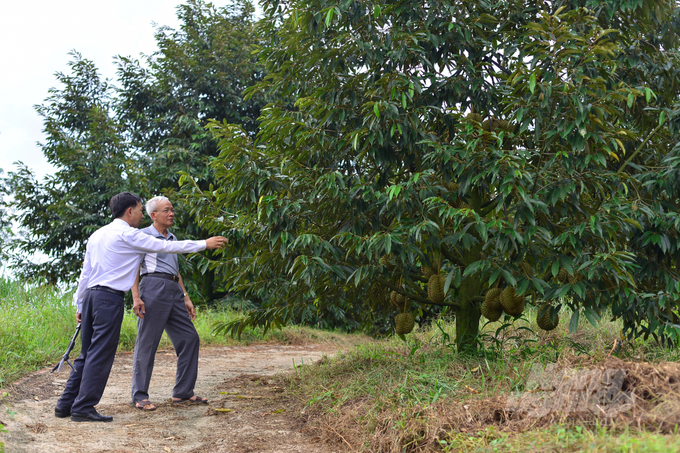700 ha of strawberries with nematode disease
On February 15, the delegation of the Ministry of Plant Protection worked with the Ministry of Agriculture and Rural Development of Lam Dong Province on the production situation and implemented the 2022-2023 Winter-Spring Harvest Harvest Prevention and Control Policy.

Mr. Nguyen Van Chau, Deputy Director of the Ministry of Agriculture and Rural Development in Lam Dong, reported with the delegation of the Ministry of Plant Protection on the production situation of the 2022 – 2023 winter-spring crop. Min Hau.
At the meeting, Mr. Nguyen Van Chau, deputy director of the Ministry of Agriculture and Rural Development in Lam Dong, said that the entire province sown 37,000 ha/40,000 ha of annual crops in the winter-spring crop of 2022-2023 (reaching the 91.1% of the plan), in which: the rice area is about 6.5 thousand ha/8.9 thousand ha (which is 73.2% of the plan); the corn area already sown is 1.3 thousand ha/1.7 thousand ha, reaching 75.3% of the plan; Vegetables, beans of all kinds were sown on about 25.3 thousand ha/25.2 thousand ha; Flowers of all kinds, cultivated area 3.7 thousand ha/3.6 thousand ha.
For permanent crops, the province has 172 thousand hectares of coffee, 11 thousand hectares of tea, 22 thousand hectares of cashews, 1.9 thousand hectares of pepper, almost 10 thousand hectares of mulberry, 7.7 thousand hectares of macadamia, 773 hectares of lemon rope, 9 thousand hectares of rubber, 31 thousand hectares of fruit trees of all kinds .
With regard to the code of the cultivation area and the packaging plant, 5 codes have currently been assigned for the entire federal state. Therein 1 code of Durian planting area covering 150 ha of Long Thuy Company, 2 codes of durian packing plants of Long Thuy Company and Trung Bao Tin Group Company, 2 codes of passion fruit planting area covering 111 ha Truong Hoang Company and Bao Long Duc Trong Company.

Recently, Lam Dong Province registered harmful organisms, diseases on coffee, durian, cashew, vegetables, flowers… and took preventive measures. Picture: Min Hau.
Regarding the epidemic situation, Mr. Ha Ngoc Chien, director of Lam Dong Plantation and Plant Protection Subdepartment, said that the province has harmful organisms and diseases on coffee, durian, cashew and all kinds of diseases, vegetables, flowers… and preventive and implemented control measures.
As for the nematode disease on mulberry trees, in 2022 the province will record about 700 ha of mulberries in low-lying waterlogged areas, affected perennial mulberry gardens. For the affected area, the agricultural sector has trained, disseminated and guided people to use pesticides, especially biological drugs, to combat it. For heavily infected areas, the agricultural sector recommends that people switch crops.
According to the Lam Dong Plantation and Plant Protection Agency, the site in Don Duong and Duc Trong districts has historically registered 215 hectares of leaf curl virus disease crops and 248 hectares of powdery mildew disease plants, of which 25 hectares are severely infected. . For nightshade leaf curl virus disease and mulberry nematode disease, prevention is still difficult because part of the people do not follow the instructions and recommendations of the agricultural industry. Many areas of the garden were heavily infected and had to be rotated, but farmers still organized sowing, so the disease continued to break out and spread.
“Currently, the price of cocoons is high, so people keep growing strawberries and don’t accept crop rotation, although the agribusiness recommended it. This is one of the causes of the outbreak of the disease,” said Nguyen Van Chau, deputy director of the Ministry of Agriculture and Rural Development of Lam Dong Province.
Accelerated the output of area codes for durian cultivation
At the meeting, the head of the Ministry of Agriculture and Rural Development Lam Dong said that in the past period the preselection of planting, the local durian packing facility code was granted to help companies promote official exports through the Chinese market. Therefore, the Ministry of Agriculture and Rural Development of Lam Dong Province suggested that the Ministry of Plant Protection continue to assist the locality in issuing growing area codes and packaging codes for this agricultural product.

Lam Dong Province proposed to the Plant Protection Agency and other functional agencies to support local import of silkworm seed eggs for production. Picture: Min Hau.
Mr. Ha Ngoc Chien, director of the Plantation and Plant Protection Sub-department of Lam Dong Province, suggested: “Currently, the province has about 16,000 hectares of durian, but only 150 hectares have been coded and 2,000 hectares need to be completed on the file.” . Some cooperative groups have difficulty in making proposals for the allocation of planting area codes, so they urgently need the plant protection department to support them and eliminate difficulties. A growing area code will help durian production cooperatives boost exports to the Chinese market.”
The Ministry of Agriculture and Rural Development of Lam Dong Province also proposed to the Plant Protection Ministry to remove difficulties for companies exporting cut flowers to Australia, since that market bans the use of the active ingredient glyphosate to treat flowering sprouts. At the same time, the Plant Protection Department has proposed solutions to help Lam Dong import proprietary flower varieties for production. At the same time, support the local import of silkworm eggs.
Mr. Nguyen Van Chau suggested, “The mulberry industry of Lam Dong Province is developing well, comparable to the former golden age. The province currently has nearly 10,000 hectares of mulberry, the basic strawberry varieties meet the production, but the varieties still have to be imported from China within the quota. Therefore, the province urgently needs support from the Plant Protection Bureau, ministries and agencies to support the import of silkworm seeds.”
According to the Plant Protection Office, the problem of the glyphosate active ingredient in the treatment of flowering shoots has now been eliminated. The Department of Plant Protection and the Australian side have agreed to use the active substance metsulfuron-methyl as a replacement for the active substance glyphosate. Therefore, the ministry suggested that the agricultural sector of Lam Dong province notifies the companies so that they can grasp and register the regulations.
Mr. Huynh Tan Dat, deputy director of the plant protection department, said that Lam Dong has a rather complicated plant variety structure, and the use and management of agricultural materials is still difficult. For viruses on nightshade, nematodes on mulberry, diseases on coffee, tea, pus streak disease on durian… the Ministry of Plant Protection will assign appropriate units to check them and pass them on to the population and implement them. In particular, encourage people to reduce pesticide use and increase the use of organic fertilizers and biological pesticides. In the case of infectious diseases from many different sources, it is necessary to check the source of infection in order to find appropriate solutions on this basis …
At the meeting, the Plant Protection Department also called on Lam Dong Province to coordinate with agencies, units and companies to develop plans and implement effective disease control measures.
In Lam Dong Province, there are currently 2,267 farms producing and trading agricultural materials, including 670 seed production and business companies, 1,597 fertilizer and pesticide production and trading companies.
In 2022, the authorities suddenly inspected 174 fertilizer, pesticide and plant variety trading establishments and discovered 58 violations, dealt with 46 violations, and 1 case was transferred to a police station. During the investigation, 1 case was transferred to the People’s Committee of Lam Dong Province for proper handling . The total amount of the fine is VND 597 million.
In 2022, Lam Dong also checked the quality of 78 samples of fertilizers and pesticides (26 samples of pesticides, 52 samples of fertilizers), discovered 11 samples of unsatisfactory quality, 10 samples of fake fertilizers…

